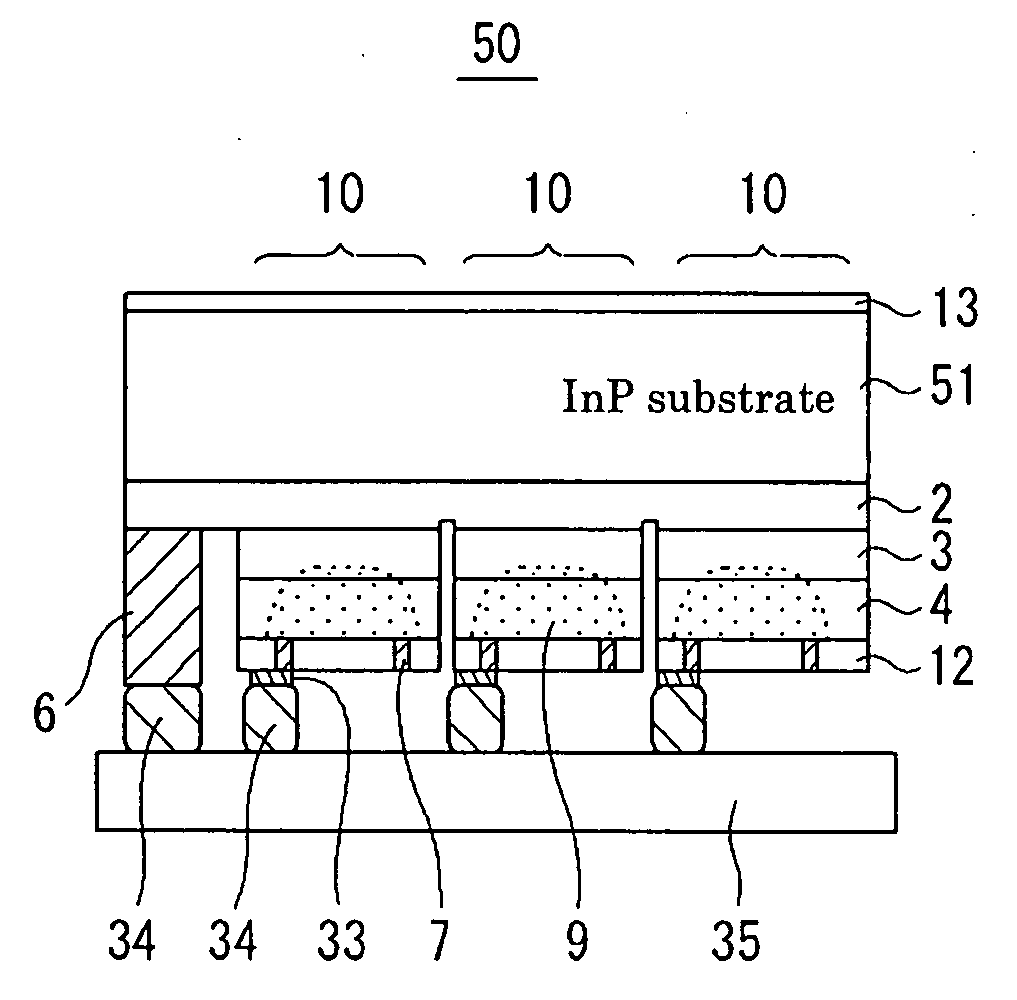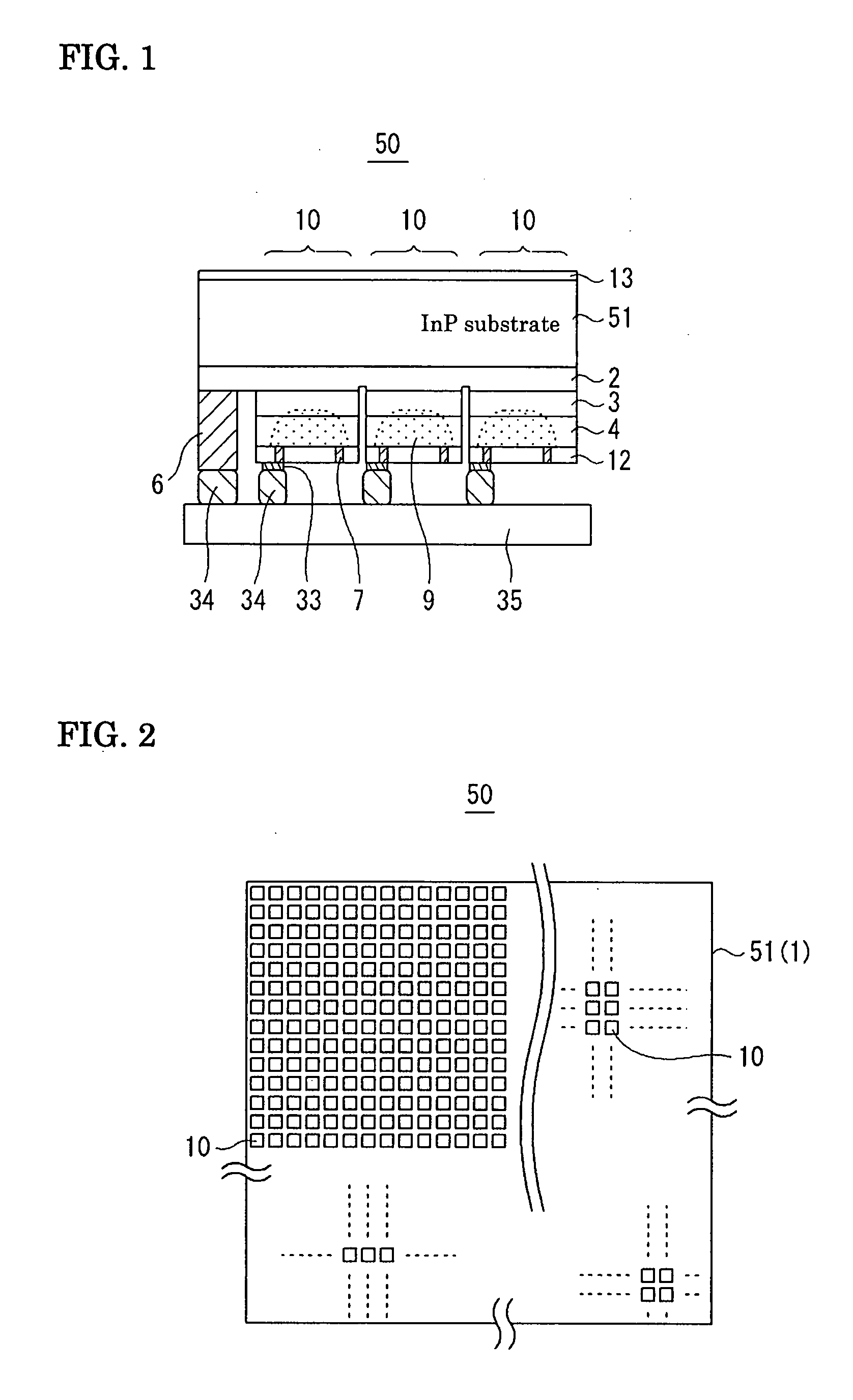Photodetector
a technology of photodetector and crosstalk, which is applied in the field of photodetector to achieve the effect of improving the crosstalk characteristics of the photodetector and low crosstalk
- Summary
- Abstract
- Description
- Claims
- Application Information
AI Technical Summary
Benefits of technology
Problems solved by technology
Method used
Image
Examples
first embodiment
[0059]FIG. 1 is a sectional view showing a photodetector according to a first embodiment of the present invention. In a photodetector 50, an AR film 13 is disposed on the top side of an InP substrate 51, and an epitaxial layer including an absorption layer 3 for each photodiode 10 is disposed on the bottom side, i.e., the mounting side. The p-electrode to be used may be ring-shaped or crescent-shaped. In this embodiment, a ring-shaped p-electrode 7 is disposed so as to be exposed from a SiN passivation film 12. An electrode wire 33 is extracted from the p-electrode 7, and thus the p-electrode 7 and an n-electrode 6 are connected to wires of a multiplexer 35 via InP solder 34. Signals from each photodiode 10 are processed by the multiplexer 35 for image formation. FIG. 2 is a schematic diagram showing a photodiode array according to the first embodiment of the present invention. Hereinafter, description will be omitted on the multiplexer, the InP solder, etc., because they are hardly...
second embodiment
[0068]FIG. 7 is a sectional view showing a photodetector according to a second embodiment of the present invention. A photodetector 50 includes an array of epitaxial-side-down mounted (flip-chip mounted) photodiodes 10. The photodiodes 10 are disposed on a common n-type InP substrate 51, and isolated from adjacent photodiodes by means of separation grooves 17. Each photodiode has a structure including n-type InP buffer layer 2 / absorption layer 3 / InP window layer 4 / passivation film 12 disposed in that order on the InP substrate. This embodiment is characterized in that a dent region 22 is provided in the center of the photodiode on the surface of the InP substrate 51 on the light-incident side in epitaxial-side-down mounting, and an AR film 23 is disposed on the bottom surface of the dent region. The dent region 22 corresponds to an incident-side-limited condensing part. An n-electrode 6 is provided on the n-type InP buffer layer 2, thus enabling flip-chip mounting. Each p-electrode ...
third embodiment
[0079]FIGS. 12 to 14 are each a sectional view showing a photodetector according to a third embodiment of the present invention. A photodetector 50 includes an array of epitaxial-side-down mounted (flip-chip mounted) photodiodes 10. The photodiodes 10 are disposed on a common n-type InP substrate 51, and isolated from adjacent photodiodes by means of separation grooves 17. Each photodiode has a structure including n-type InP buffer layer 2 / absorption layer 3 / InP window layer 4 / passivation film 12 disposed in that order on the InP substrate. This embodiment is characterized in that an optical element, which is an incident-side-limited condensing part, is disposed on the surface of the InP substrate 51, which is the light-incident surface in epitaxial-side-down mounting. In the photodetector shown in FIG. 12, the optical element is a lens 27. In FIG. 13, the optical element is a diffraction grating 28. In FIG. 14, a photonic crystal 29 is disposed. An n-electrode 6 is provided on the ...
PUM
 Login to View More
Login to View More Abstract
Description
Claims
Application Information
 Login to View More
Login to View More - R&D
- Intellectual Property
- Life Sciences
- Materials
- Tech Scout
- Unparalleled Data Quality
- Higher Quality Content
- 60% Fewer Hallucinations
Browse by: Latest US Patents, China's latest patents, Technical Efficacy Thesaurus, Application Domain, Technology Topic, Popular Technical Reports.
© 2025 PatSnap. All rights reserved.Legal|Privacy policy|Modern Slavery Act Transparency Statement|Sitemap|About US| Contact US: help@patsnap.com



